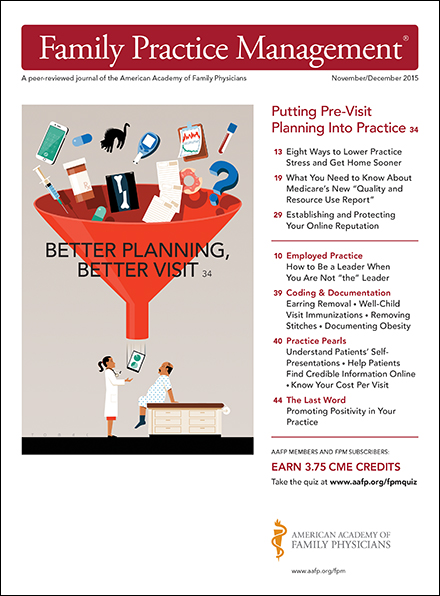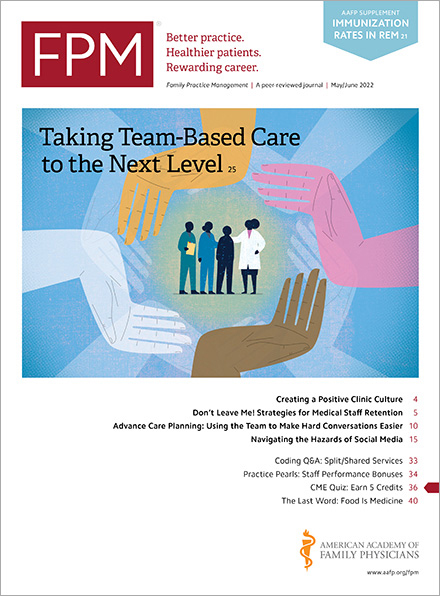Transformations to Reduce Chart Review Burden
Learn about organizational changes a practice can make to modify its workflow and operations. Transformations to improve chart burden range from pre-visit planning to adopting an entirely new practice model.
Team-based pre-visit planning
Save time and increase satisfaction by letting your team help you prepare for each appointment ahead of time.
Team-based care
Streamline patient visits by teaming with your medical assistant (MA) or nurse to gather and organize information before seeing the patient.
Pre-visit planning allows you to focus on what matters most to the patient, saving you time and increasing your patient’s satisfaction as well as your own.
You can streamline patient visits by teaming with your MA or nurse to gather and organize all necessary information before seeing the patient. This can eliminate time (as much as 10 minutes) spent scrambling to address:
- who the patient is,
- why the patient is here,
- which performance measures are due,
- what care has been received since the last visit,
- what other practice, ER, or hospitalization should be recorded,
- what new results (lab, imaging, diagnostics, consults) have been received since the last visit, and
- what medications the patient takes.
Conducting pre-visit planning
“Look back”
Have your MA do a “look back” at the chart a week or so before the next visit to ensure that the plan from the previous visit has been executed and results are in the chart.
Place orders to get results before the visit
Have your MA ready orders such as labs based on the patient’s conditions or medications. The results would then be available for review at the patient’s visit.
Use pre-visit calls for complex patients
Have your MA call your complex patients to reconcile medications, anticipate problems, and screen for other factors (e.g., fall risks or depression), and then reconfirm at the face-to-face visit.
Conduct regular huddles
A morning mini-huddle with your MA lets you provide the best possible care to patients.
Dedicate a team member to complex patients
This person can identify high-risk patients and monitor their progress toward quality metrics.
- Check that the quality metric data is accurately assigned
- Update any missing metrics that have been met
- Contact patients who need to be seen to achieve specific quality metrics
- Order protocol-based labs or studies that patients need to satisfy outcome metrics
- Review patient satisfaction surveys and provide feedback to team

FPM: Putting Pre-Visit Planning Into Practice
When you walk in to see your next patient, is all of the necessary information assembled, organized, and ready? Or do you spend the first five to 10 minutes of each appointment determining who the patient is, why the patient is here, which performance measures are due, and what care the patient may have received from another provider, the emergency department, or an urgent care center since the previous visit?
The “team” in team-based care varies based on the organization, its patient population’s risk profile, and its resources.
In general, it is considered an advanced care team with in-room support. At its simplest, it includes a clinician and two or three medical assistants or nurses who are sometimes designated as care team coordinators (CTCs). These CTCs require greater skills as more care responsibilities are shared.
Teams can be extended further with the addition of advanced practice health care professionals under the physician’s direction, with each having a designated MA or nurses in the team care coordinator role. Beyond that, health professionals such as pharmacists, social workers, or behaviorists might be shared across teams.
[inset Diagrams of the team structure of simple and more extended team- the VBP leaders are on the more extended team end of the spectrum]
The goal is to allow the team members to practice at the top of their licenses. The physician can then focus more on the patient, listen deeply, make accurate diagnoses, create better treatment plans, react to the patient’s preferences, and engage with the extended team of health professionals to ensure comprehensive care is delivered.
Evidence shows that team-based care can:
- increase patient access to care,
- increase productivity by allowing practices to see more patients and provide comprehensive care,
- increase efficiency,
- improve quality,
- increase revenue, and
- provide tangible cost savings.

FPM: Taking Team-Based Care to the Next Level
The need to delegate tasks to other members of the health care team has never been more urgent. Learn how to move toward advanced team-based care.